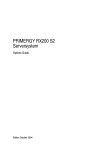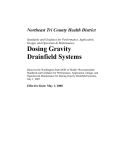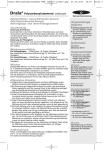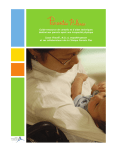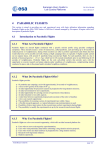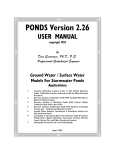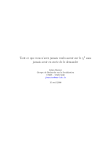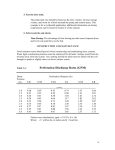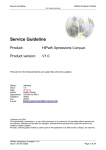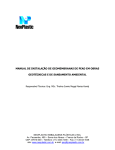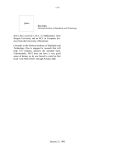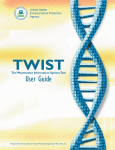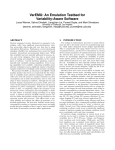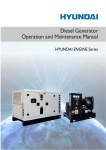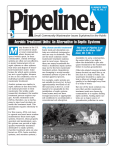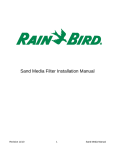Download Stratified Sand Filter Treatment Systems
Transcript
Northeast Tri County Health District Standards and Guidance for Performance, Application, Design, and Operation & Maintenance Stratified Sand Filter Treatment Systems Based on the Washington State DOH of Health “Recommended Standards and Guidance for Performance, Application, Design, and Operation & Maintenance for Stratified Sand Filter Treatment Systems, July 1, 2007 Effective Date: May 1, 2008 NETCHD--Stratified Sand Filter Treatment Systems -- Standards and Guidance Effective Date: May 1, 2008 Contents Page Introduction........................................................................................................................3 1. Performance Standards ................................................................................................3 1.1. Performance Criteria ..................................................................4 2. Application Standards ..................................................................................................4 2.1. Listing ...........................................................................................4 2.2. Permitting.....................................................................................4 2.3. Influent Characteristics ..............................................................5 2.4. Pretreatment ................................................................................5 2.5. Location Requirements ...............................................................6 2.6. Installation Issues ........................................................................6 2.7. Disposal Component....................................................................6 3. Design Standards...........................................................................................................6 3.1. Design Approval - Before construction can begin, the design must be approved by the health officer. All site inspections before, during, and after the construction must be accomplished by the health officer............................7 3.2. Filter Bed......................................................................................7 3.3. Depth (thickness) of media - Sand and corresponding support gravels shall be as indicated in Section 3.2.1(b), and in Figure 2 of Appendix A. ..7 3.4. Filter bed containment - The filter bed is contained either in a flexible membrane-lined pit, or a concrete vessel. Design and construction must conform to the containment standards set forth in Appendix C.................................7 3.5. Vent tubes.....................................................................................7 3.6. Wastewater Distribution.............................................................8 4. Operation and Maintenance ........................................................................................8 4.1. Management.................................................................................8 4.2. User’s Manual..............................................................................9 4.3. Maintenance.................................................................................9 4.4. Action Conditions ......................................................................11 Appendix A – Figures ......................................................................................................12 Appendix B - Filter Media Specifications......................................................................14 Appendix C - Containment Vessel Standards ...............................................................15 Appendix D - Underdrains..............................................................................................22 Appendix E -- Inspection/Monitor Ports .......................................................................24 Appendix F - Disposal of Contaminated Filter Media .................................................25 Appendix G - Bibliography .............................................................................................26 Glossary of Terms: A common glossary of terms for all RS&Gs can be found on the DOH Web site at http://www.doh.wa.gov/ehp/ts/ww/pubs-ww-rsg.htm#glossary. Throughout this document, new terms introduced that are included in the Glossary appear for the first time in italics. Page 2 of 27 NETCHD--Stratified Sand Filter Treatment Systems -- Standards and Guidance Effective Date: May 1, 2008 Typical RS&G Organization: Standards Section Explanation Performance How this technology is expected to perform (treatment level and function) Application How this technology is to be applied. This section includes conditions that must be met prior to proceeding with design. Topics in this section describe the “approved” status of the technology, component listing requirements, permitting, installation, testing and inspection requirements, etc. Design How this technology is to be designed and constructed (includes minimum standards that must be met to obtain a permit). Operation and Maintenance How this technology is to be operated and maintained (includes responsibilities of various parties, recommended maintenance tasks and frequency, assurance measures, etc) Appendices Design examples, figures and tables, specific applications, and design and installation issues. Introduction The stratified sand filter is a modified intermittent sand filter, the difference being the particle size and layering of the filter media. While this type of sand filter is an adaptation of proven water treatment technology, the on-site sewage treatment design/regulatory community has presently little "real world" experience with stratified sand filters. Wastewater, having received initial treatment in a septic tank, or equivalent wastewater sedimentation/initial treatment unit, is applied to a bed of media. This sand filter bed is constructed with layers of specific filter sand media, in sequential order, separated by supporting layers of gravel. Oxygen is provided to the sand/gravel interfaces by vent tubes placed throughout the filter. The wastewater is dispersed into a drain rock layer atop the sand bed by pressure distribution. Applied in doses, the wastewater flows downward as unsaturated flow through the media. Biological treatment occurs on the surface of the filter media particles. The treated wastewater (filtrate) is collected at the bottom of the sand filter, and discharged, either by gravity or by pressure, to a suitable, approved final treatment/disposal unit, usually a conventional sub-surface drainfield. 1. Performance Standards Page 3 of 27 NETCHD--Stratified Sand Filter Treatment Systems -- Standards and Guidance Effective Date: May 1, 2008 1.1. Performance Criteria 1.1.1. Stratified sand filters when constructed and used according to these standards and guidance, are expected to perform to Treatment Levels A and B. 1.1.2. Effluent from a stratified sand filter can be discharged to 12 inches of vertical separation. 2. Application Standards 2.1. Listing 2.1.1. Stratified sand filters are a generic alternative technology and therefore are not listed in the Washington State Department of Health (DOH) List of Approved Systems and Products as a proprietary system, but may be permitted by the health officer as there is a DOH Standard and Guidance document available. 2.2. Permitting 2.2.1. Installation permits must be obtained from the health officer prior to installation and use. 2.2.2. Interim Special Requirements for Stratified Sand Filters - To further our knowledge regarding the effectiveness and function of stratified sand filters under controlled conditions, the following requirements must be met for their use. 2.2.2.1. A stratified sand filter is used only on sites which meet all the requirements for an intermittent sand filter. 2.2.2.2. Before the sewage system permit is issued, appropriate agreements and documents shall be produced and signed. These documents may include but are not limited to: easements, contracts, and performance or surety bonds, but must provide for: 2.2.2.2.1. the sampling and testing required in item (c), below. 2.2.2.2.2. the replacement of the filter media and reconstruction of the filter to the requirements for an intermittent sand filter if: 2.2.2.2.2.1. at any time in the two year period, sample results indicate that the stratified sand filter has failed to produce effluent quality equivalent to expectations for an intermittent sand filter, or 2.2.2.2.2.2. the stratified sand filter fails to function or perform to the satisfaction of the health officer. This includes, but is not limited to, conditions such as clogging or other failure of the media, and Page 4 of 27 NETCHD--Stratified Sand Filter Treatment Systems -- Standards and Guidance Effective Date: May 1, 2008 overflowing or other premature discharge of inadequately treated wastewater. 2.2.2.3. For a two year period following commissioning, quarterly, 24-hour composite effluent samples shall be drawn and analyzed for TSS, BOD5, Ammonium, Nitrate, and Fecal Coliform. 2.2.2.4. In the future, the TRC will evaluate data collected from stratified sand filters in use in Washington State and re-evaluate the continued necessity for imposing the additional requirements listed above. 2.3. Influent Characteristics 2.3.1. Residential Wastewater: Stratified sand filters are designed for treating residential strength wastewater. The wastewater applied to the stratified sand filter must not be higher in strength than treatment level E (or grab samples with results no greater than 220 mg/l BOD5 or 145 mg/l TSS). Lower wastewater strengths, without increased flow rates are preferable for assuring long term operation of a stratified sand filter system. 2.3.2. Non-Residential Wastewater: High-strength wastewater and wastewater from non-domestic sources (such as restaurants, hotels, bed and breakfast establishments, industrial and commercial wastewater sources) must be individually evaluated for treatability and degree of pretreatment required prior to a stratified sand filter for final treatment and disposal. 2.3.3. Daily Wastewater Flow 2.3.3.1. Residential -- For all residential applications, a minimum wastewater design flow of at least 120 gallons/bedroom/day must be used. 2.3.3.2. Non-Residential -- For non-residential applications, a minimum wastewater design flow equal to 150% of the estimated daily flow should be used. 2.4. Pretreatment 2.4.1. If the wastewater is residential sewage, settleable and floatable solid separation by a properly sized two-compartment septic tank with effluent baffle screening will suffice. Pretreatment with some other wastewater sedimentation/initial treatment unit may be used instead of a septic tank. 2.4.2. If the wastewater is from a non-domestic source, influent to the sand filter must be equivalent to residential strength septic tank effluent. Page 5 of 27 NETCHD--Stratified Sand Filter Treatment Systems -- Standards and Guidance Effective Date: May 1, 2008 Aerobic treatment or some other treatment process may be needed to modify the influent to the stratified sand filter to within the range of residential septic tank effluent quality. 2.5. Location Requirements 2.5.1. The minimum setback requirements for stratified sand filters are the same as those required for septic tanks in WAC 246-272A-0210. 2.6. Installation Issues 2.6.1. If the containment vessel is constructed of a 30 mil PVC liner, the liner must be protected by a 3 inch layer of sand beneath the liner. 2.7. Disposal Component 2.7.1. Direct discharge of effluent from a stratified sand filter to surface water or upon the ground surface is prohibited by WAC 246-272A-0230. Subsurface disposal is required. 2.7.2. WAC 246-272A provides for SSAS design allowances, which vary according to treatment performance levels. 2.7.3. The size and design of the disposal component must be consistent with the methods and procedures indicated by WAC 246-272A-0200, WAC 246-272A0220, WAC 246-272A-0230, and WAC 246-272A-0234. 2.7.4. Disposal component location must meet minimum horizontal setback distances as specified by WAC 246-272A-0210 and 246-272A-0280. 2.7.5. Development using a stratified sand filter must meet the minimum land area requirements specified in WAC 246-272A-0320. 2.7.6. When the site evaluation indicates the depth of soil to a water table is less than 18 inches, there is a need to confirm that there are at least 12 inches during the wet season. Therefore when there is any doubt that there is sufficient unsaturated soil depth, the permit should be held for a wet season evaluation to identify accurately the location of high water tables. As potential vertical separation (or soil depth) decreases seasonal site checks to evaluate water table levels become increasingly critical to the on-site sewage system design, function, and to the protection of public health. 3. Design Standards Page 6 of 27 NETCHD--Stratified Sand Filter Treatment Systems -- Standards and Guidance Effective Date: May 1, 2008 3.1. Design Approval - Before construction can begin, the design must be approved by the health officer. All site inspections before, during, and after the construction must be accomplished by the health officer. 3.2. Filter Bed 3.2.1. Media Specifications 3.2.1.1. Filter media must meet the particle size criteria detailed in Appendix B. Media used in constructing a stratified sand filter must be accompanied with a written certification from the supplier that the media fully conforms to the particle size criteria as determined by ASTM D136 and ASTM C117. 3.2.1.2. Layer thickness, support gravel placement (See Figure 2 of Appendix A): Top Layer - 10 inches thick, Supported by a 4 inch thick layer of 3/4 inch gravel. Middle Layer - 4 inches thick, Supported by a 4 inch thick layer of 3/4 inch gravel. Bottom Layer - 10 inches thick, Supported and underdrained by gravel and pipe. (See Appendix D. Underdrains) 3.2.1.3. Surfaces of each layer must be level before adding the next layer. 3.2.2. Loading Rate: The loading rate shall not exceed 1.0 gallons/day/square foot, using the appropriate daily wastewater flow design estimate. 3.2.3. Surface area of filter bed: The surface area must be determined by dividing the design flow estimate by the loading rate. 3.3. Depth (thickness) of media - Sand and corresponding support gravels shall be as indicated in Section 3.2.1(b), and in Figure 2 of Appendix A. 3.4. Filter bed containment - The filter bed is contained either in a flexible membrane-lined pit, or a concrete vessel. Design and construction must conform to the containment standards set forth in Appendix C. 3.5. Vent tubes 3.5.1. Vent tubes are an integral component of the stratified filter. Their number and placement must meet the requirements indicated in Figures 2 and 3 of Appendix A. Page 7 of 27 NETCHD--Stratified Sand Filter Treatment Systems -- Standards and Guidance Effective Date: May 1, 2008 3.5.2. Each tube must be constructed from 4 inch diameter or larger pipe manufactured according to ASTM D 3034 standards. Each vent must have a threaded cap at the top end, which extends above final grade, to prevent unwanted objects from entering the filter. Venting is provided by a series of 30, 1/8 inch diameter holes located in the vent tube corresponding to each of the gravel layers, the base support gravel at the bottom of the filter, and around the cap on top of the vent. (This would equate to a total of 120, 1/8 inch diameter holes in each vent tube) If the drilled holes are covered with 1/8th inch plastic mesh suitable for possible corrosive conditions within the filter environment, eight, 1/2 inch diameter holes at each of the respective locations, may be used. See Figure 2 of Appendix A. 3.6. Wastewater Distribution 3.6.1. Pressure distribution: Pressure distribution is required and must comply with the pressure distribution standards and guidance. This requirement applies to all pressure distribution related components. 3.6.2. Wastewater application to the filter bed: The wastewater must be applied to the layer of drain rock atop the filter media, or sprayed upward against the top of gravelless chambers. 3.6.3. Treated Wastewater (Filtrate) Collection & Discharge -- Filtrate may be collected and discharged from the bottom of the sand filter by either a gravity-flow underdrain system, or a pressure-flow pumpwell system. When sand filters are membrane-lined, gravity-flow underdrains must exit through a boot, and the boot and exit pipe must be installed and tested according to the standards in Appendix C. 4. Operation and Maintenance 4.1. Management 4.1.1. The health officer has the authority to require that an acceptable maintenance agreement be established, and supporting documents be developed and approved by the health officer, prior to the issuance of approvals for a proposed sand filter sewage system. It is recommended that a maintenance agreement be required when, in the opinion of the health officer, the ongoing operation of the sand filter sewage systems is best assured by the existence of such an agreement. Page 8 of 27 NETCHD--Stratified Sand Filter Treatment Systems -- Standards and Guidance Effective Date: May 1, 2008 4.2. User’s Manual 4.2.1. A user’s manual for the sand filter system must be developed and / or provided by the system designer. These materials must contain the following, at a minimum: 4.2.1.1. Diagrams of the system components. 4.2.1.2. Explanation of general system function, operational expectations, owner responsibility, etc. 4.2.1.3. Names and telephone numbers of the system designer, Northeast Tri County Health District, component manufacturer, supplier/installer, and/or the management entity to be contacted in the event of a failure. 4.2.1.4. Information on "Trouble-shooting" common operational problems that might occur. This information should be as detailed and complete as needed to assist the system owner to make accurate decisions about when and how to attempt corrections of operational problems, and when to call for professional assistance. 4.2.1.5. For proprietary sand filter devices, a complete maintenance and operation document must be developed and provided by the manufacturer. This document must be made available, through the system designer, to the system owner. This document must include all the appropriate items mentioned above, plus any additional general and site-specific information useful to the system owner, and/or the maintenance person. A copy of this document must also be provided to the health officer, prior to the issuance of the installation permit. 4.3. Maintenance 4.3.1. Responsibility - For the on-site treatment and disposal system to operate properly, its various components need periodic inspection and maintenance. The maintenance is the responsibility of the homeowner, but may be best performed by experienced and qualified service providers. An Operation and Maintenance Manual must be developed and/or provided by the system designer with copies provided to the health officer, system owner and maintenance contractor. The maintenance manual must include the following listed recommended maintenance descriptions and schedules. The health officer may specify additional requirements: 4.3.1.1. Minimum Maintenance Description and Service Items. 4.3.1.2. Type of use. Page 9 of 27 NETCHD--Stratified Sand Filter Treatment Systems -- Standards and Guidance Effective Date: May 1, 2008 4.3.1.3. Age of system. 4.3.1.4. Specifications of all electrical and mechanical components installed (occasionally components other than those specified on the plans are used). 4.3.1.5. Nuisance factors, such as odors or user complaints. 4.3.1.6. Septic tank: inspect yearly for structural integrity, proper baffling, screen, ground water intrusion, and proper sizing. Inspect and clean effluent baffle screen and also pump tank as needed. 4.3.1.7. Pump chamber: clean the effluent screen (spraying with a hose is a common cleaning method), inspect and clean the pump switches and floats yearly. Pump the accumulated sludge from the bottom of the chambers, whenever the septic tank is pumped, or more often if necessary. 4.3.1.8. Pumpwell: Inspect for infiltration, structural problems and improper liquid level. Check for pump or siphon malfunctions, including problems related to dosing volume, pressurization, breakdown, clogging, burnout, or cycling. Pump the accumulated sludge from the bottom of the pumpwell, whenever the septic tank is pumped, or whenever necessary. The liquid level at the pump start or siphon must be below the bottom of the filter media in order to prevent ponding and rise of the capillary fringe in the sand. Improper liquid level (too high in the pumpwell) can result from improper setting of the pump on float, pump burnout, disconnected electrical supply to the pump or controls, or tripped circuit breaker. In some cases the underdrain may be underdesigned and may not have the flow capacity to supply the pump at the rate that it pumps. Infiltration into the pumpwell is serious and means that the effluent is entering the pumpwell before passing through the full column of sand. Effluent that is short circuiting will not receive full sand filter treatment. 4.3.1.9. Check monitoring ports for ponding. Conditions in the monitoring ports must be observed and recorded by the service provider during all operation and maintenance activities for the sand filter and other system components. 4.3.1.10. Inspect and test yearly for malfunction of electrical equipment such as timers, counters, control boxes, pump switches, floats, alarm system, junction box, or other electrical components, and repair as needed. System checks should include improper setting or failure, of electrical, mechanical, or manual switches. 4.3.1.11. Mechanical malfunctions (other than those affecting sewage pumps) including problems with valves, or other mechanical or plumbing components. Page 10 of 27 NETCHD--Stratified Sand Filter Treatment Systems -- Standards and Guidance Effective Date: May 1, 2008 4.3.1.12. Material fatigue, failure, corrosion problems, or use of improper materials, as related to construction or structural design. 4.3.1.13. Neglect or improper use, such as loading beyond the design rate, poor maintenance, or excessive weed growth. 4.3.1.14. Installation problems, such as improper location or failure to follow design. 4.3.1.15. Overflow or backup problems where sewage is involved. 4.3.1.16. Specific chemical/biological indicators, such as BOD, TSS, fecal coliforms, etc. Sampling and testing may be required by the health officer on a caseby-case basis, depending on the nature of the problem, availability of laboratories, or other factors. 4.3.2. Information on the safe disposal of discarded filter media. See Appendix F. 4.4. Action Conditions 4.4.1. When inspections, or any other observation, reveals either of the following listed conditions, the owner of the system must take appropriate action, according to the direction and satisfaction of the health officer: 4.4.1.1. drainfield system failure, as defined in WAC 246-272A-0010, or 4.4.1.2. stratified sand filter fails to function or perform to the satisfaction of the health officer and/or fails to produce effluent quality equivalent to expectations for a stratified sand filter. 4.4.2. Appropriate Actions Upon Identification of Action conditions: 4.4.2.1. repair or modification of the drainfield system, 4.4.2.2. expansion of the drainfield system, 4.4.2.3. modifications or changes within the structure relative to wastewater strength or hydraulic flows, 4.4.2.4. replacement of the stratified sand filter in accordance with Section 2.2.2.2. Page 11 of 27 NETCHD--Stratified Sand Filter Treatment Systems -- Standards and Guidance Effective Date: May 1, 2008 Appendix A – Figures Figure 1: Typical Layout of a Stratified Sand Filter STRATIFIED SAND FILTER SEPTIC TANK PUMP CHAMBER DRAINFIELD Figure 2: Typical Cross-section of a Stratified Sand Filter Vent Tube 4" Sandy Top Soil Cover Approved geotextile filter fabric 8" 3/4 Gravel with Distribution pipe 10" Filter Sand 4" Pea Gravel 4" Fine Sand 4" Pea Gravel 10" Glass Sand Pea Gravel with Underdrain Vent holes at each location (see Section 3.5.2) Page 12 of 27 NETCHD--Stratified Sand Filter Treatment Systems -- Standards and Guidance Effective Date: May 1, 2008 Figure 3: Typical Vent Pipe Layout, Top View VENT PIPE NOT MORE THAN 4 FT. PUMPWELL NOT MORE THAN 8 FT. Page 13 of 27 NETCHD--Stratified Sand Filter Treatment Systems -- Standards and Guidance Effective Date: May 1, 2008 Appendix B - Filter Media Specifications I Particle Size Analysis - The standard method to be used for performing particle size analysis must comply with one of the following: A the sieve method specified in ASTM D136 and ASTM C-117 B the method specified in Soil Survey Laboratory Methods and Procedures for Collecting Soil Samples, Soil Survey Investigation Report #1, US Department of Agriculture, 1984. II Stratified Sand Filter Particle size distribution: TOP LAYER Particle Size Percent Retained 2.00 mm 0 1.40 mm 0 to 14 1.18 mm 3 to 32 0.850 mm 28 to 86 0.600 mm 63 to 97 0.425 mm 84 to 100 0.300 mm 96 to 100 MIDDLE LAYER Particle Size Percent Retained 0.850 mm 0 to 2 0.600 mm 7 to 17 0.425 mm 37 to 61 0.300 mm 83 to 89 0.212 mm 97 to 99 0.180 mm 99 to 100 0.150 mm 100 BOTTOM LAYER Particle Size Percent Retained 0.850 mm 0 0.600 mm <1 0.425 mm 9 to 11 0.150 mm 94 to 96 0.106 mm 99 0.75 mm 100 Page 14 of 27 NETCHD--Stratified Sand Filter Treatment Systems -- Standards and Guidance Effective Date: May 1, 2008 Appendix C - Containment Vessel Standards I. Lined Pit: when a sand filter is constructed in an excavated pit the following criteria are to be met. (Note: The majority of the following liner specification is from the State of Oregon On-Site Sewage Disposal Rules.) A. Polyvinyl chloride (PVC) shall have the following properties: PROPERTY TEST METHOD ASTM D1593 Para 9.1.3 ASTM D792 Method A ASTM D882 (a) Thickness (b) Specific Gravity (Minimum) (c) Minimum Tensile Properties (each direction) Breaking Factor (pounds/inch width) Elongation at Break (percent) Modulus (force) at 100% Elongation (pounds/inch width) (d) Tear Resistance (pounds, minimum) (e) Low Temperature (f) Dimensional Stability (each direction, percent change maximum) (g) Water Extraction (h) Volatile Loss Resistance to Soil Burial (percent change maximum in original value) (A) Breaking Factor (B) Elongation at Break Modulus at 100% Elongation (j) Bonded Seam Strength (factory seam, breaking factor, ppi width) (k) Hydrostatic Resistance 30 mil minimum Method A or B (1 inch wide) Method A or B 69 300 Method A or B 27 ASTM D1004 Die C ASTM D1790 ASTM D1204 212°F, 15 min. ASTM D1239 ASTM D1203 Method A ASTM D3083 8 -20°F ±5 -0.35% max. 0.7% max. -5 -20 ±10 ASTM D3083 55.2 ASTM D751 Method A 82 Page 15 of 27 NETCHD--Stratified Sand Filter Treatment Systems -- Standards and Guidance Effective Date: May 1, 2008 B. Installation Standards 1. Patches, repairs and seams shall have the same physical properties as the parent material; 2. Site considerations and preparation: a. The supporting surface slopes and foundation to accept the liner shall be stable and structurally sound including appropriate compaction. Particular attention shall be paid to the potential of sink hole development and differential settlement; b. Soil stabilizers such as cementations or chemical binding agents shall not adversely affect the membrane; cementations and chemical binding agents may be potentially abrasive agents. 3. To avoid deterioration of the membrane liner caused by exposure to weather or sunlight, the liner must be protected by being fully buried. In cases where portions of the liner may be subject to direct exposure to the weather (for example in a recirculating gravel filter system in which the top edges of the liner may not be buried due to the system design requirements), the exposed portions of the liner must be covered. (An example might be to construct a finish rim over the exposed liner portions.) 4. Non-reinforced liners have high elongation and can conform to irregular surfaces and follow settlements within limits. Unreasonable strain reduces thickness and may reduce life expectancy by lessening the chemical resistance of the thinner (stretched) material. Every effort shall be made to minimize the strain (or elongation) anywhere in the flexible membrane liner; 5. Construction and installation: a. Pit / surface / preparation: (1) bottom of pit: (a) covered with sand to "bed" liner, adequate in depth (minimum 3") to protect liner from puncture, or (b) use a non-woven needle-punched synthetic geotextile fabric, in a thickness appropriate to the tasks of protecting the liner. (c) sides of the pit smooth, free of possible puncture points. (d) bottom of pit (bedding layer of sand) graded to provide a sloping liner surface, from the outer edge of the filter toward the point of underdrain Page 16 of 27 NETCHD--Stratified Sand Filter Treatment Systems -- Standards and Guidance Effective Date: May 1, 2008 collection. Slope equal to 8 inches fall overall or one inch of fall per foot of run, whichever is the greatest. b. Climatic conditions: (1) Temperature. The desirable temperature range for membrane installation is 42° F to 78° F. Lower or higher temperatures may have an adverse effect on transportation, storage, field handling and placement, seaming and backfilling and attaching boots and patches may be difficult. Placing liner outside the desirable temperature range shall be avoided; (2) Wind. Wind may have an adverse effect on liner installation such as interfering with liner placement. Mechanical damage may result. Cleanliness of areas for boot connection and patching may not be possible. Alignment of seams and cleanliness may not be possible. Placing the liner in high wind shall be avoided; (3) Precipitation. When field seaming is adversely affected by moisture, portable protective structures and/or other methods shall be used to maintain a dry sealing surface. Proper surface preparation for bonding boots and patches may not be possible. Seaming, patching and attaching ‘boots’ shall be done under dry conditions. c. Boots: When boots are used (required when using a gravity-flow underdrain), the boot and exit pipe must be installed with the following criteria: (1) The system designer is to identify the use of a sand filter liner with underdrain and boot as a part of the application for on-site sewage system and provide specifications detailing design and installation requirements. (2) The boot is to be installed by the manufacturer or the manufacturer's representative. (3) The boot outlet is to be bedded in sand. (4) The boot is to be sized to accommodate an underdrain outlet pipe. (5) The boot is to be secured to the underdrain outlet pipe with two (2) stainless steel bands and screws, and sealant strips as recommended by the manufacturer. (6) The underdrain is to be designed in accordance with Appendix C, Underdrains and exit the side of the liner. (7) An inspection port must be installed in the sewer pipe from the sand filter to the drainfield. Page 17 of 27 NETCHD--Stratified Sand Filter Treatment Systems -- Standards and Guidance Effective Date: May 1, 2008 (8) Sewer pipe from the sand filter to the drainfield must be ASTM 3034 ring tight. (9) When site conditions are such that the trench from the sand filter to the drainfield may act as a conduit for ground water movement towards the drainfield (for example on sites with shallow groundwater of poorly drained sites), the trench must be back-filled with a minimum 5 lineal feet clay mix (or bentonite mix) dam. (10) If the boot may be submerged in a seasonal high water table, performance testing of the sand filter/boot for leakage must be conducted in the following manner: (i) Block outlet pipe; (ii) Fill underdrain gravel with water; (iii) Measure and record elevation of water through an observation/inspection port; (iv) Let stand 24 hours minimum; (v) Measure and record elevation of water through observation/inspection port; (vi) No allowable drop in the water level. d. Liner Placement: (1) Size. The final cut size of the liner shall be carefully determined and ordered to generously fit the container geometry without field seaming or excess straining of the linear material; (2) Transportation, handling and storage. Transportation, handling and storage procedures shall be planned to prevent material damage. Material shall be stored in a secured area and protected from adverse weather; (3) Site inspection. A site inspection shall be carried out by the health officer prior to liner installation to verify surface conditions, etc.; (4) Deployment. Panels shall be positioned to minimize handling. Seaming should not be necessary. Bridging or stressed conditions shall be avoided with proper slack allowances for shrinkage. The liner shall be secured to prevent movement and promptly backfilled; Page 18 of 27 NETCHD--Stratified Sand Filter Treatment Systems -- Standards and Guidance Effective Date: May 1, 2008 (5) Anchoring trenches. The liner edges should be secured frequently in a backfilled trench; (6) Field seaming. Field seaming, if absolutely necessary, shall only be attempted when weather conditions are favorable. The contact surfaces of the materials should be clean of dirt, dust, moisture, or other foreign materials. The contact surfaces shall be aligned with sufficient overlap and bonded in accordance with the suppliers recommended procedures. Wrinkles shall be smoothed out and seams should be inspected by nondestructive testing techniques to verify their integrity. As seaming occurs during installation, the field seams shall be inspected continuously and any faulty area repaired immediately; (7) Field repairs. It is important that traffic on the lined area be minimized. Any necessary repairs to the liner shall be patched using the same lining material and following the recommended procedure of the supplier; (8) Final inspection and acceptance. Completed liner installations shall be visually checked for punctures, rips, tears and seam discontinuities before placement of any backfill. At this time the installer shall also manually check all factory and field seams with an appropriate tool. In lieu of or in addition to manual checking of seams by the installer, either of the following tests may be performed; (a) Wet Test: The lined basin shall be flooded to the one (1) foot level with water after inlets and outlets have been plugged. There shall not be any loss of water in a 24 hour test period. (b) Air Lance Test: Check all bonded seams using a minimum 50 PSI (gauge) air supply directed through a 3/16 inch (typical) nozzle held not more than 2 inches from the seam edge and directed at the seam edge. Riffles indicate unbonded areas within the seam, or other undesirable seam construction. II. Lined Framework - A perimeter support frame to hold the liner in place during construction may be used. Framework shall be straight, free from warps or bends. Framework shall be of sufficient rigidity so that springing will not occur under the weight of the media and/or backfill placement. Framework shall be sufficiently supported to prevent excessive deflection of the framework. Plywood with 2x4 framing support (on minimum 2’ centers) is a suggested method. Treated wood should be used to prevent deterioration of the wood by termites, decomposition, etc. A. Media and liner placement: Page 19 of 27 NETCHD--Stratified Sand Filter Treatment Systems -- Standards and Guidance Effective Date: May 1, 2008 1. It is important that sand is placed between the framework and excavated soil simultaneously with placement of the treatment media. This keeps the framework and liner vertical during the course of construction and results in a sand cushion around the outside perimeter of the lined framework. All nails or staples used must have their sharp ends pointed away from the liner. The PVC liner is unfolded from the center of the excavation and draped over the top edges of the perimeter support frame. Care should be taken to prevent contact between the liner and the sharp edges of the top of the perimeter support frame. A garden hose which has been cut longitudinally and placed on the top edge of the support frame would be a suggested method. 2. Care must be taken to ensure that the liner is in full contact with the bottom and sides and that no bridging occurs. Pleats or wrinkles in the liner should be minimized. Pleats and wrinkles in the liner may allow for a tunneling effect of effluent through the pleat or wrinkle. B. Backfill around framework: If site conditions are such that a partially elevated filter is desired or necessary, backfill around the sides of the filter shall be non-clay material and not contain pieces more than 3 inches across and any frozen lumps, wood, or other foreign material. The backfill material around the sides of the filter shall be placed in layers no more than 2 feet thick (loose), with each layer tamped and graded so that final settling will provide for side slopes on the sides of the filter backfill to be approximately 3:1 from the top of the filter, to native ground. III. Concrete Containment Vessel: A. Above ground tank - to be designed and/or approved by a qualified professional engineer if the following conditions are not met. 1. Walls a. at least 6 inches thick b. Above ground height is 4 feet or less c. rebar reinforcement: 3/8 inch diameter rebar on 2-foot centers horizontally and vertically, with continuous lengths wrapped around the corners. 2. Floor a. at least 3 1/2 inches thick Page 20 of 27 NETCHD--Stratified Sand Filter Treatment Systems -- Standards and Guidance Effective Date: May 1, 2008 b. reinforced with steel mesh (CRSI standard #6-1010) to prevent cracking and to maintain water-tightness 3. Tank is to be designed, constructed, and sealed to be water-tight. B. Below ground tank. Any below-ground concrete tank must be water-tight. The design of any such tank is to be approved by a qualified professional engineer and the health officer. Page 21 of 27 NETCHD--Stratified Sand Filter Treatment Systems -- Standards and Guidance Effective Date: May 1, 2008 Appendix D - Underdrains For Concrete Tanks or Synthetic Membrane-Lined Pits: Either gravity underdrains or pumpwells may be used. Underdrains must be designed with sufficient void storage volume to provide for a single drainfield dose with reserve capacity to maintain unsaturated filter media above the underdrain system. Collection pipe must be sized of sufficient size, with adequate perforations, or slots so that filtrate can flow from the void storage space into the collection pipe rapidly enough to maintain unsaturated filter media above the underdrain system. However, the minimum size of the collection pipe shall be 4” diameter. Underdrains may be designed in a variety of ways. One possible way is: Place a 3 inch layer of pea gravel over a 6 inch layer of 3/4 to 2-1/2 inch gravel containing the underdrain collection pipe. The purpose of the pea gravel is to restrict the migration of sand into the gravel and pipe in the underdrain. The gravel surrounding the slotted or perforated pipe should be sized larger than the slots or perforations to prevent migration of gravel into the pipe. See Figure 1. For the purpose of calculating void storage space in the medium gravel (3/4 to 2-1/2 inch), 3.0 gallons per cubic foot may be used assuming 40% void space per cubic foot. Figure 4 - Typical Cross-section of a Stratified Sand Filter Underdrain Liner Gravel for Storage Slotted Pipe for Transport Double Clamps of Filtrate on Boot Page 22 of 27 NETCHD--Stratified Sand Filter Treatment Systems -- Standards and Guidance Effective Date: May 1, 2008 Pumpwells are located within the filter. Filtrate is collected in an underdrain system underlying the filter media and is discharged directly into the pumpwell. Pumpwells may be designed a variety of ways, but they must be constructed of concrete or plastic sewer pipe. A sufficient number and size of holes must exist in the pumpwell, at the level of the underdrain system, so that filtrate can flow into the pumpwell, from the underdrain void space, as rapidly as the filtrate is pumped out of the pumpwell. The pumpwell must be adequately supported on both sides of the synthetic membrane. Figure 5 - Typical Cross-section of a Pumpwell in a Synthetic Membrane-lined Stratified Sand Filter Lid for Access Large Diameter Pipe [Water tight except for diischarge & underdrain] Liner Gravel for Storage Slotted Pipe for Transport of Filtrate to Pumpwell Support for Pumpwell and Pump Page 23 of 27 NETCHD--Stratified Sand Filter Treatment Systems -- Standards and Guidance Effective Date: May 1, 2008 Appendix E -- Inspection/Monitor Ports Screw Type Cap or Slip Cap Screw Type Cap or Slip Cap 4" PVC Pipe (Length Varies) 4" PVC Pipe (Length Varies) 1/4 x 4" Long Slots (4) @ 90* Apart Toilet Ring 4" PVC Tee Screw Type Cap or Slip Cap 3/8" - 1/4" Rebars 4" PVC Pipe (Length Varies) 1/2" Holes (4) for Rebars 1/4" Slots END VIEW (BOTTOM) 1/4" Slot Page 24 of 27 NETCHD--Stratified Sand Filter Treatment Systems -- Standards and Guidance Effective Date: May 1, 2008 Appendix F - Disposal of Contaminated Filter Media Whenever filter media is removed from a used filter, removing and disposing of contaminated filter media is to be done in a manner approved by the health officer. Handle this material carefully by using adequate protective sanitation measures. Thoroughly wash hands and any other exposed skin with hot water and soap, following contact with contaminated sand filter media. This material may be applied to the soil, according to the following, only when approved by the health officer. APPLICATION RESTRICTIONS/TIMETABLE 1. Root crops, low-growing vegetables, fruits, berries used for human consumption. Contaminated material must be stabilized and applied 12 months prior to planting. 2. Forage and pasture crops for consumption by dairy cattle. Forage and pasture crops not available until one month following application of stabilized material. 3. Forage and pasture crops for consumption by non-dairy livestock. Forage and pasture crops not available until two weeks following application of stabilized material. 4. Orchards or other agricultural area where the material will not directly contact food products. Or where stabilized material has undergone further treatment, such as pathogen reduction or sterilization. Less severe restrictions may be applicable. Page 25 of 27 NETCHD--Stratified Sand Filter Treatment Systems -- Standards and Guidance Effective Date: May 1, 2008 Appendix G - Bibliography Boyle, W.C. and Richard J. Otis, "On-Site Treatment", EPA Training Manual, Prepared for Environmental Research Information Center, ORD, USEPA, July 1979. Design Manual: On-site Wastewater Treatment and Disposal Systems. U.S. EPA, EPA-625/180-012 October 1980 Final Report, Oregon On-site Experimental Systems Program, December 1982; Oregon Department of Environmental Quality Glossary of Water and Wastewater Control Engineering; Joint Editorial Board of the AWWA, WPCF, ASCE, APHA, Copyright 1969 Gross, Mark A., Optimum Depth of Sand for Filtering Septic Tank Effluent; Masters Degree Thesis, Master of Science, University Of Arkansas, 1981. Gross, Mark, Dee T. Mitchell, Biological Virus Removal from Household Septic Tank Effluent; Proceedings of the Fourth National Symposium on Individual and Small Community Sewage Systems, ASAE, December 1984, New Orleans, Louisiana. Gross, Mark, Ph.D., P.E., Dee Mitchell, Household Wastewater Virus Removal by Sand Filtration; 1988 Revision. Hathaway, Randy J., Dee T. Mitchell, Sand Filtration of Septic Tank Effluent For All Seasons Disposal By Irrigation, Proceedings of the Fourth National Symposium on Individual and Small Community Sewage Systems, December 1984, New Orleans, Louisiana Hines, Michael and R.E. Favreau, Recirculating Sand Filter: An Alternative to Traditional Sewage Absorption Systems, Proceedings of National Home Sewage Disposal Symposium, December 1974. Loudon, T.L., G.L. Birnie, Jr., Performance of Trenches Receiving Sand Filter Effluent in Slowly Permeable Soils, Proceedings of the 6th National Symposium on Individual and Small Community Sewage Systems, ASAE, December, 1991, Chicago, IL. Management of Small Waste Flows, Final Report of the Small Scale Management Project, University of Wisconsin, EPA 600/2-78-173. Mitchell, Dee, Sand Filtration of Septic Tank Effluent, Proceedings of the 5th Northwest On-site Wastewater Treatment Short Course, University of Washington, September 1985 Mitchell, Mike D. P.E., Writings, Northwest Septic, Inc., Mt. Vernon, Washington. Page 26 of 27 NETCHD--Stratified Sand Filter Treatment Systems -- Standards and Guidance Effective Date: May 1, 2008 On the Performance of Experimental Sand Filters in the State of Oregon, Oregon Department of Environmental Quality. Koerner, Robert M., Ph.D., P.E., Designing with Geosynthethics, Prentice-Hall Otis, Richard, P.E., Soil Clogging: Mechanisms and Control, Proceedings of the 4th National Symposium on Individual and Small Community Sewage Systems, ASAE, December 1984, New Orleans, LA. Otis, Richard J., P.E., On-site Wastewater Treatment Intermittent Sand Filters, Rural Systems Engineering, Madison, Wisconsin. Sauer, D.K., W.C. Boyle, and Richard J. Otis. "Intermittent Sand Filtration." ASCE/EE, August 1976 Scherer, Billy P., Dee T. Mitchell, Individual Household Surface Disposal of Treated Wastewater without Chlorination; Proceedings of the Third National Symposium on Individual and Small Community Sewage Treatment, December 1981, Chicago, Illinois. Siegrist, Robert L., Hydraulic Loading Rates for Soil Absorption Systems Based on Wastewater Quality, Proceedings of the 5th National Symposium on Individual and Small Community Sewage Systems, ASAE, December 1987, Chicago, IL Technology Assessment of Intermittent Sand Filters. U.S. EPA, Office of Municipal Pollution Control, Project Officer: James F. Kreissl. Authors: Damann L. Anderson, Robert L. Seigrist, Richard J. Otis. Tyler, E. Jerry, James C. Converse, Soil Acceptance of Onsite Wastewater as Affected by Soil Morphology and Wastewater Quality, Proceedings of the 7th International Symposium on Individual and Small Community Sewage Systems, ASAE, December 1994, Atlanta, GA. Page 27 of 27



























